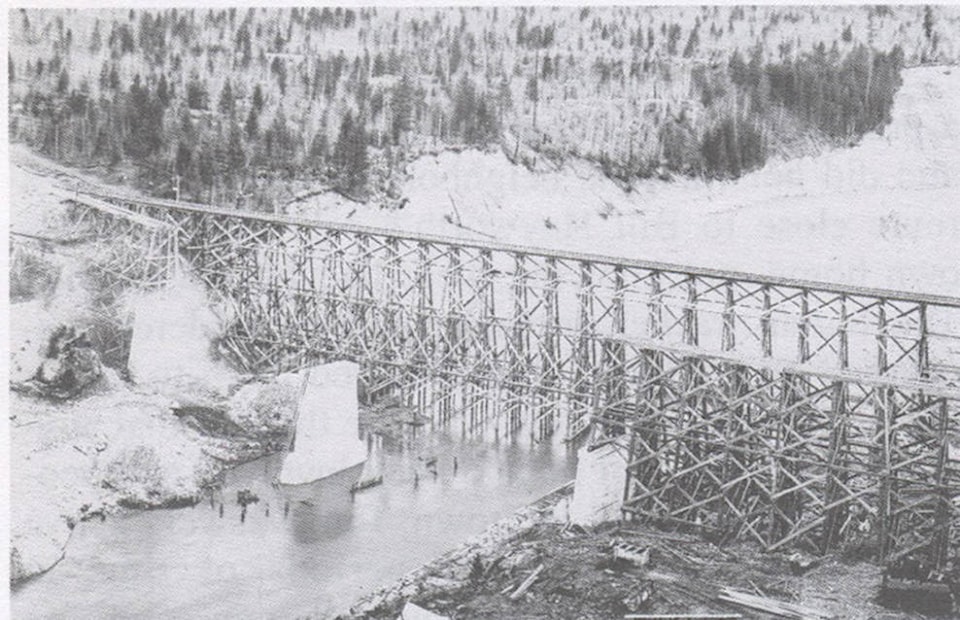The following is an excerpt from Upper North Thompson Reflections
As told by Jack Moilliet
to Joan Unterschultz
M.A. Phillips and Chamberlain were two resident civil engineers in about 1913. The C.N. Railroad built them two nice cabins at Mile 100, known as Waburn Siding.
Two bridges were built at Irvine; the first was a wooden trestle type to enable the trains to start running in 1915. A second bridge was started in 1916 beside the first bridge; this one had cement piers and was made of steel.
This was a tremendous undertaking and supplied work for many people in the valley.
Another bridge built in the area was the Lions Creek wooden trestle at Cottonwood Flats, just north of Avola. This was also a very high one and was damaged by fire when an uncontrolled forest fire raged through the area.
An oncoming train crossed the bridge while it was on fire. One of the conductors on this train was “Sharkie” Shawm Winnifred Sedgwick’s father.
The bridge was repaired, but soon another decision was made to fill the canyon. A narrow gauge track was put in uphill and was used to haul fill material to the construction site, taking three years.
Also in this area is Little Tunnel at Messiter. This tunnel was used until the late 1930s when it started to deteriorate. Originally it was thought to be of rock but with train traffic increasing, it started to crumble and became unusable as it turned out to be sandstone and clay instead. An alternate route was made around the area.
In the late 1920s, there was a big problem with the CN bridge, just north of Birch Island. They figured it had been damaged in the flood of 1928. A decision was made to try and lower the level of the North Thompson River to enable repairs to be made in 1929. A diversion was made through a small gully, which lowered the river enough to permit repairs to the bridge. After the water started down the gully it was hard to stop it as it involved a large part of the river going down the wrong way.
As a result of this diversion, several acres of Bill Hayworth’s land washed away. He asked for compensation and after receiving the money he was murdered.
Someone who knew he had this money, shot him with a shotgun through the window of his home. It was felt the culprit was a local person, but this was never proven.
The thieves knocked down the door and ransacked the place, spilling sugar, rolled oats, etc., on the floor. It was thought that this was to cover up the bloodstains, but the mystery was solved when old Bill’s groceries were sold to neighbours and they found $20 bills in some of the rolled oats, flour and sugar containers.
Bill had not trusted banks and had hidden his money in his groceries. No doubt there were lots of people who had queer places of hiding their money. After the thieves left, Old Bill crawled to his bed, where he froze to death before neighbours found him.
Apparently, about this time, Tom Montgomery, a prospector, and dear old soul, had shot a deer, and did not want his neighbours to know, so he took a route close to Bill Hayworth’s cabin, back to his own home, not knowing there was a murder. The native tracker, looking for the murderer, discovered Tom’s tracks and followed them to Tom’s place.
This horrified Tom when he thought that anyone could think that he had been involved and people say this is why he left town. Tom was very active in the valley, staying for periods of time at Moilliets, prospecting, mapping the area, and was trusted by many people. He took Ted Moilliet, when 12-years-old, up Foghorn Mountain to show him the tunnels.
Montgomery, with partner Dan Dobson, discovered the Lydia mine at Birch Island. Dan sold the mine and left town, not giving Tom any money.
